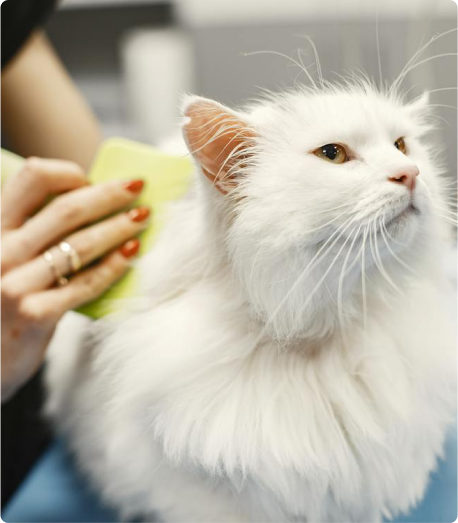Bringing a new cat into your home is an exciting adventure, but it’s essential to introduce your new feline friend in a way that ensures a smooth transition for everyone involved. At Brooklyn Pet Spa, we understand the importance of a proper introduction to help your new cat adjust and thrive in their new environment. Here’s a step-by-step guide to introducing a new cat to your home effectively.
Table of Contents
Toggle1. Prepare a Safe Space
Tip: Before bringing your new cat home, set up a quiet and comfortable space just for them. This should include a bed, litter box, food and water bowls, and some toys. Ideally, this space should be separate from your other pets initially.
Why It Matters: A dedicated space helps your new cat feel secure and gives them a chance to acclimate to their new surroundings without being overwhelmed. It also prevents any immediate confrontations with existing pets. Make sure this space is equipped with essentials to minimize stress and support your cat’s adjustment.
2. Introduce Your Cat Gradually
Tip: Start by allowing your new cat to explore their safe space and get comfortable with their new environment. Gradually introduce them to other areas of the house once they seem relaxed and confident.
Why It Matters: Gradual exposure helps prevent your cat from becoming overwhelmed. Allowing them to explore at their own pace reduces stress and helps them adjust more comfortably to their new home. Gradual introductions to other rooms can also help your cat become familiar with their new environment in a non-threatening way.
3. Facilitate Controlled Introductions with Other Pets
Tip: When introducing your new cat to existing pets, do so gradually and in a controlled manner. Start by allowing them to sniff each other’s scent through a closed door. Swap bedding or use a pheromone diffuser to help them get used to each other’s scent.
Why It Matters: Controlled introductions help prevent aggressive or fearful reactions from both your new cat and existing pets. Gradual scent introduction helps them become familiar with each other without direct contact, easing the transition. Additionally, using a pheromone diffuser can help create a more relaxed atmosphere for both your new and existing pets.
4. Supervise Initial Interactions
Tip: When you’re ready for face-to-face introductions, supervise the interactions closely. Keep initial meetings short and positive, gradually increasing the time they spend together as they become more comfortable.
Why It Matters: Supervised introductions ensure that you can intervene if any aggressive behavior or stress occurs. Positive reinforcement, such as treats and praise, can help create a positive association with the presence of other pets. This careful management helps to build trust and prevent conflicts during these critical early interactions.
5. Provide Plenty of Enrichment and Playtime
Tip: Engage your new cat with interactive toys, scratching posts, and climbing structures. Providing enrichment helps keep them mentally stimulated and helps reduce stress.
Why It Matters: Enrichment helps your new cat adapt more quickly to their new home by providing them with activities and distractions that ease their transition. It also helps prevent boredom and encourages positive behavior. Regular playtime and mental stimulation can significantly improve your cat’s adjustment process and overall well-being.
6. Monitor Your Cat’s Behavior and Health
Tip: Keep an eye on your new cat’s behavior and health during the adjustment period. Look for signs of stress, such as hiding, lack of appetite, or excessive grooming. Consult your veterinarian if you notice any concerning symptoms.
Why It Matters: Monitoring your cat’s behavior and health ensures that they are adjusting well and allows you to address any issues promptly. Early intervention can prevent more serious health problems and ease your cat’s adjustment process. Keeping a journal of their behavior can also help track their progress and identify any areas needing attention.
7. Establish a Routine
Tip: Create a consistent daily routine that includes feeding, playtime, and quiet time. Consistency helps your new cat understand what to expect and feel more secure in their new environment.
Why It Matters: A predictable routine helps your cat adjust more quickly by providing a sense of stability and security. Knowing when to expect meals, playtime, and rest helps reduce anxiety and build confidence. Routine also fosters a sense of normalcy, making your cat’s new home feel more like their permanent residence.
8. Be Patient and Give It Time
Tip: Remember that adjusting to a new home takes time, and every cat is different. Be patient with your new feline friend and allow them to set their own pace for adjusting to their new surroundings.
Why It Matters: Patience is key to ensuring a smooth transition for your new cat. Allowing them to acclimate at their own pace helps build trust and ensures they feel secure and comfortable in their new home. Rushing the process can lead to increased stress and potential setbacks in their adjustment.
Welcome Your New Cat with Confidence!
Introducing a new cat to your home requires thoughtful preparation and a gradual approach. By creating a safe space, facilitating controlled introductions, and providing enrichment, you’ll help your new feline friend adjust smoothly to their new environment.
At Brooklyn Pet Spa, we offer grooming and behavioral consultations to support your cat’s well-being during this transition period. Our expert team is dedicated to helping your cat feel comfortable and confident. Contact us today to learn more about how we can help make your new cat’s introduction a success.
Brooklyn Pet Spa – Where Your New Cat Feels Right at Home!
For more information or to schedule a consultation, feel free to reach out. We’re here to support you and your new feline friend every step of the way!








